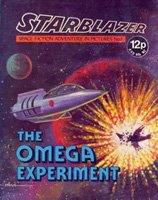
Publisher: DC Thomson
First issue: 1 April 1979
Last issue: 1 January 1991
Issues: 281
In the latter half of the 1900s an international law was passed that decreed every new science fiction thing had to have the word “Star” in the title…
There was Star Wars, Star Trek, Starlord, Star-Lord, Starman, Starman, Starman, Battlestar Galactica, Dark Star, Bonjo from Beyond the Stars, Battle Beyond the Stars, Star Crash, Starburst, Star Fire, Star Cops, The Last Starfighter, Starlog, Star Heroes, Star Odyssey, Jason of Star Command, Stargate, Starslammers, The Last Starship, Starship Troopers, Stars in Their Eyes, A Star is Born, Lone Star, Little Star, The Daily Star, Five-Star, Jim Starlin, Starsky & Hutch and Tony Stark to name but however many that is. And let’s not forget the phenomenal pop-culture phenomenon that was He-Man and the Mastars of the Universe.
So in the late 1970s, after IPC’s 2000AD had shown that a British science fiction comic could be successful even if it wasn’t based on an already-existing popular property (i.e., Doctor Who, Star Wars, Planet of the Apes, Dan Dare), DC Thomson decided that they needed a new science fiction (or “Space Fiction” as they called it) title to add to their impressive arsenal of digest-sized comics, and so they created Spacejacket.

Sorry. I mean, Starblazer.

(Not to be confused with: Star Blazers, the American adaptation of the Japanese anime series Space Battleship Yamato.)
On its release I thought that DC Thomson really should have called their new comic something like Space Commando to link it with the most successful of their digestives, but in the intervening decades I’ve come to like the title they chose, partly because it has the word “lazer” hidden away in there — a subtle and clever reference to those old pulp SF writers who didn’t know (or didn’t care) that “Laser” is actually an acronym and it’s not supposed to have a Z.
DC Thomson had occasionally featured SF-themed stories in their regular weekly comics — such as “Smasher” in Bullet, “Toro – Space Samurai” in The Victor, “Arena” in The Crunch, “The Supercats” in Spellbound and Debbie (originally called “The Fabulous Four” when they first appeared in Diana) — or as one-off tales in their other digests, but few of them were really memorable for the right reasons, so Starblazer was by no means a sure thing. They took a chance, and it paid off.
Starblazer stood apart from 2000AD in many respects aside from its size: it featured one story per issue, rarely had more than three panels per page, and most of the stories were stand-alone (though there were some recurring characters and storylines). Miss an issue, or read them out of sequence, and it generally didn’t matter. So it was less of direct competitor to 2000AD than, say, Marvel UK’s Future Tense (Nov 1980 to Jan 1982, 41 issues).

It’s worth pointing out here (before that guy on-line loudly points it out because he thinks that if I don’t mention something it’s because I don’t know it) that Starblazer didn’t stick rigidly to science fiction: it dabbled in fantasy stories, too, and in fact with issue 168 the comic’s tagline was changed from “Space Fiction Adventure in Pictures” to “Fantasy Fiction in Pictures.” (Plus there had been a few diversions along the way for “Space Role-Playing Game in Pictures” — I’ve not seen any of those issues but I expect the tagline is self-explanatory.)
Like all DC Thomson comics, the stories in Starblazer were uncredited but time and doggedness have allowed fans and historians to discover the creators involved. Comics greats like Cam Kennedy, Ian Kennedy, Mike McMahon, Colin MacNeil, Grant Morrison, Keith Page, John Ridgway and John Smith all lent (or, well, sold) their talents to Starblazer and really helped to elevate it.
Cost-wise, Starblazer‘s launch price of 12p (for B&W 64 pages, not including the covers) was a little on the expensive side: contemporary issues of Commando cost only 10p, as did 2000AD, Tornado, Battle-Action (for those interested: at the same time, Twinkle and Tammy cost 9p, Debbie, Buster & Monster Fun, Warlord and Bullet were 8p, The Beano and The Dandy were only 6p). But Starblazer was comparatively better value by the time of its demise, when issues cost 35p against 2000AD‘s 45p, so arguably Starblazer won that particular battle.
Was Starblazer ground-breaking? Sadly, no, not especially. It certainly didn’t lead to a new wave of tiny SF comics: off-hand, I can’t think of a single imitator back in the day. Was it quality stuff? Not always, but now and then the stories and art were outstanding. Was it worth collecting at the time? Oh yes — if you could find it, that is. My local newsagent stopped stocking it in the early 1980s and it was several years before I discovered that it was still in print.
Is Starblazer worth collecting now? Well, that’s between you and your wallet. I understand that later issues can be devilishly hard to track down, but if you’ve got the money, patience, and the space to store them all (and the time and inclination to read them, of course, because that’s the whole point of comics in the first place), then it’s definitely worth the effort.
Starblazer lasted for 11¾ years, and while it might not have truly blazed the stars, it did shine very brightly at times.
The deservedly-award-winning Down the Tubes blog features an absolutely excellent and comprehensive look at Starblazer‘s history and legacy — do check it out!


Thanks for the mention of our Starblazer resource. We’re finding out new things occasionally – the artist on two covers recently identified!
LikeLike